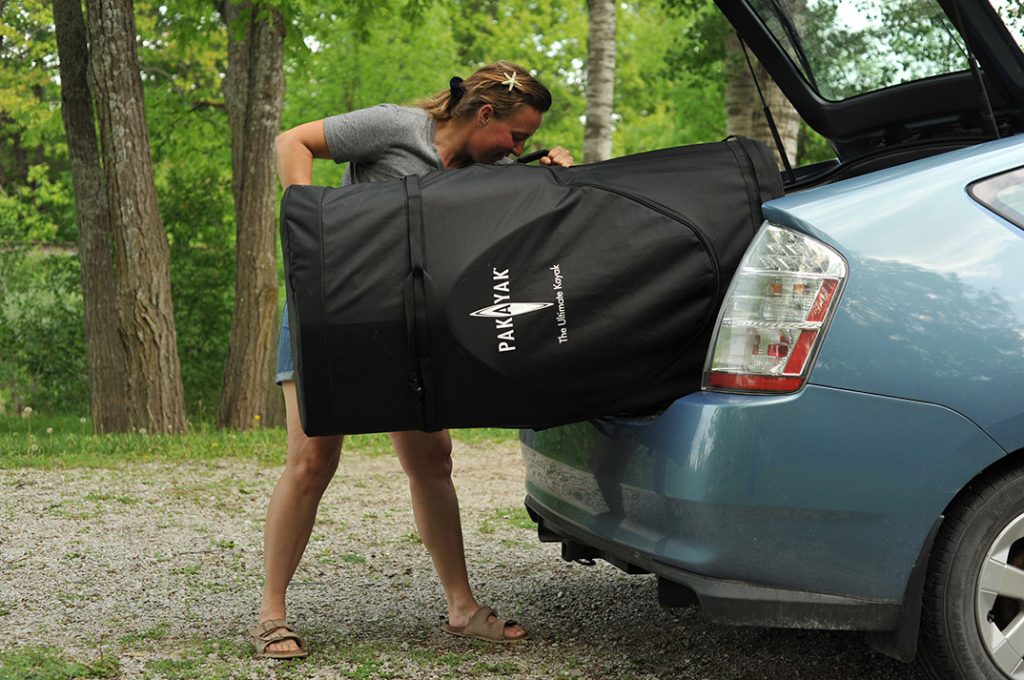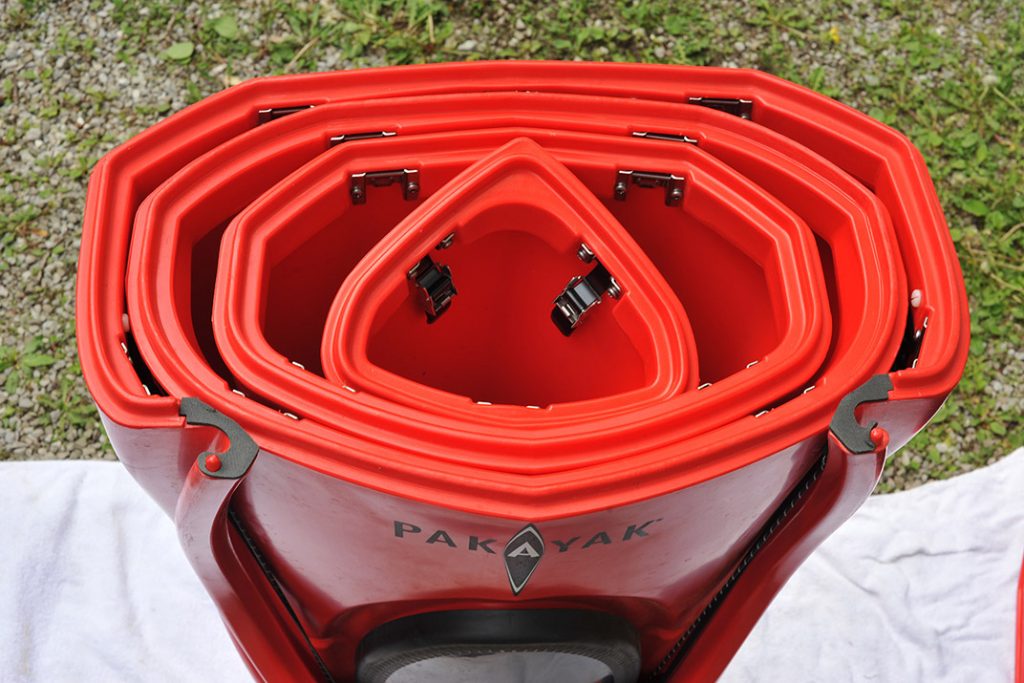Until recently, a kayak’s off-water stealth didn’t factor into most paddlers’ purchasing decisions. Portable kayaks—an eclectic catch-all of inflatable, folding and sectional models—appealed chiefly to space-starved urban paddlers prioritizing easy storage and transportation, or international adventurers preoccupied with airline baggage restrictions. Now, in the midst of a global health crisis the Pakayak Bluefin 14 offers the intriguing prospect of under-the-radar pandemic paddling.
Pakayak Bluefin 14 Specs
Length: 14’
Width: 24”
Depth: 16”
Weight: 66 lbs (as tested)
Max Capacity: 300 lbs
MSRP: $,1795 USD
www.pakayak.com
The Pakayak Bluefin 14 is a portable powerhouse
Picture a kayak that stashes, out-of-sight, in your compact’s trunk or back seat and transitions from bag to boat in just three minutes. Now imagine this sectional craft, once assembled, is virtually indistinguishable from a standard polyethylene touring kayak in features, comfort and performance. This is the magic of the Pakayak Bluefin 14, or as I like to call it, the ultimate low-profile, portable kayak for maintaining mental and physical health during lockdown.
Pakayak’s Kickstarter success story
Pakayak was founded in 2016, the same year its four co-founders launched a Kickstarter campaign to fund production of the Bluefin 14, raising over $546,000. The first boats shipped in early 2018, marking nearly seven years since Pakayak visionary Doug Mackro began tinkering with the design for a modular, nesting kayak with hard-shell performance.
Starting with wood and plastic prototypes cobbled together from other kayaks, Mackro sketched plans for a full-sized kayak that could be disassembled and stacked into a bundle just three-and-a-half feet long by two feet wide.
Numerous design tweaks later, Mackro and company partnered with an experienced plastics rotomolder in Massachusetts. Manufacturing domestically allowed Connecticut-based Pakayak to ensure high quality control while minimizing their carbon footprint. You can probably think of some other benefits to keeping production, assembly and distribution at a single facility.

The Bluefin 14 is easy to assemble
Unlike some portable kayaks, you don’t need a video tutorial or engineering degree to assemble the Pakayak. Our chili red Bluefin 14 arrives neatly nestled inside a beer fridge-sized cardboard box with a single sheet of instructions.
Setup is intuitive: each successive piece removes from the nested stack and attaches to the previous piece—no tools or extra parts required. Pakayak recommends paddlers assemble the bow and stern ends vertically, then lay the two halves down for the final cockpit connections. It works like a charm—my first attempt takes about six minutes, with a bit more practice I’m snapping it together in three. Even better, it packs back up just as quickly.
Pakayak’s design team engineered the internal clamps holding the sections together to be strong, simple and foolproof. Good news, since you need to operate some of them—tucked in the ends and reached through the oval deck hatches—by feel alone. Each of the stainless-steel clamps applies over 300 pounds of pressure, with three to five clamps at every joint. Paired with the sections’ interlocking tongue-and-grooves, this results in a hull and deck that are actually stiffer than a conventional plastic boat. It’s also just as watertight, providing the silicone gasket in each groove is kept clean. If the gaskets do become worn or damaged, they can be easily swapped out with replacements available through Pakayak’s website.

All that hardware isn’t light, however. We measured our Bluefin 14 at 66 pounds, well above Pakayak’s listed 59 pounds and significantly heftier than most plastic singles of this length. Assembled, it’s a bear to maneuver on land. But that’s not the point.
Get rolling with Bluefin 14 accessories
The Bluefin’s rolling travel bag makes it simple for anyone to wheel the packed boat to water, set up and slip offshore without any assistance—and without drawing too much attention (a handful of socially distanced admirers notwithstanding). It’s an easy, independent solution for challenging times.
If your walk to the water crosses soft sand or gravel, I recommend splurging for Pakayak’s optional all-terrain wheels. Slinging the comically large package across your back with the skimpy shoulder strap is another matter—a lighter folding or inflatable craft is a better choice for remote hike-in destinations.
On the water, the Pakayak Bluefin looks and feels like a standard 14-footer, save a couple of quirks particular to its packable design. To achieve the compact nesting of sections inside one another, the boat has a distinctly fish-form shape—the hull is widest and fullest ahead of the paddler, and tapers towards the stern. The narrower beam at the paddler’s hips gives the Bluefin less stability than I expected from a 24-inch-wide touring kayak.
Bluefin packable kayaks continue to grow
At just over 6 feet, our tallest reviewer also noted he had to adjust the foot braces to their maximum position, and could comfortably rest his feet against the forward bulkhead. Pakayak has addressed fit issues with taller paddlers by introducing a slightly roomier model—the Bluefin 142—that should be available by the time you’re reading this.
The Bluefin 142 will pack into the same dimensions as the original while adding 3.5 inches of legroom in the cockpit. Updates to the clamps, seat back and travel bag are also in the works. New CNC molds replace Pakayak’s original cast aluminum molds in the manufacturing process, which the team says will increase precision and shave weight from the finished product.

In just four years, Pakayaks have shipped to over 25 countries worldwide. Pakayak-olytes praise their portability, durability, competitive price tag and user-friendly simplicity. Touring fans enjoy the safety and ease of dry bulkheads and rubber hatches. One Australian adventurer has even embarked on multi-week expeditions, packing his Bluefin 14 with 80 pounds of food, gear and water. Facing daunting conditions and 30-mile days while island-hopping in the Philippines, Marcus Hill applauded his Pakayak’s seaworthiness and generous 180 liters of hatch volume. Hill’s most recent journey ended abruptly this March, proving not even Pakayaks are pandemic-proof.
Stow and go with the Pakayak Bluefin 14
If you’ve found yourself dreaming of a kayak that fits in your car or closet, assembles in minutes and paddles like a conventional hard-shell, the Bluefin is the boat for you. If you haven’t yet looked at portable kayaks, consider the convenience and possibilities of a boat that is always with you, stashed in your trunk for stealthy tours on local waters.
This article was first published in Issue 62 of Paddling Magazine. Subscribe to Paddling Magazine’s print and digital editions, or browse the archives.
Video review of the Pakayak Bluefin 14 Packable Kayak:











Does this kayak have a keel